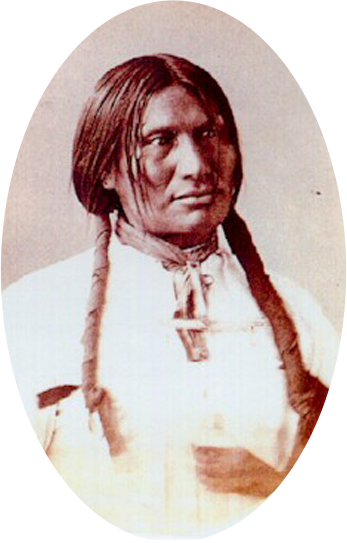Bigfoot's Lakota name was Si Tanka ,"Spotted Elk"
The son of Lone Horn, Spotted Elk became chief of the Minneconjou ("Planters by the River") after the death of his father in 1874. One of the seven subdivisions of the Teton Sioux, the Minneconjou lived in northwestern South Dakota with the Hunkpapa, another band of the Teton Sioux led by Sitting Bull. Native accounts of Spotted Elk describe him as a great hunter. He was also a skilled horseman who possessed a string of fine ponies, most often obtained from the Crow or other enemies. He was best known, however, for his political and diplomatic successes. An able negotiator, Spotted Elk was skilled at settling quarrels between rival parties and was often in great demand among other Teton bands.
After the Sioux War for the Black Hills in 1876-77, the Minneconjou were placed on the Cheyenne River Reservation in South Dakota. Being a person accustomed to finding ways of reconciling disparate views, Spotted Elk sought means to adapt to white ways. According to Native accounts, Spotted Elk was among the first American Indians to raise corn in accordance with government standards. Moreover, he traveled to Washington, D.C. and requested that a mission school be established near the forks of the Cheyenne River. While the Indian Bureau tentatively agreed, the matter was set aside and eventually forgotten.
GHOST DANCE
In 1889 Kicking Bear introduced the Ghost Dance religion to the Minneconjou. The ritual dance was developed by the Paiute medicine man Wovoka, after speaking to the creator. It was believed that the Ghost Dance would restore the world to its aboriginal state; it promised for the return of Native ancestors and all plant and animal life. Devastated by war, hunger, and disease, the Minneconjou welcomed the new religion. While their dancing never became violent, several other Sioux, who were angered by the 1883 prohibition of the Sun Dance and other "barbarous" customs by the Secretary of the Interior as well as the 1889 reduction of Sioux holdings to six small reservations, turned the Ghost Dance into a movement advocating violence against their white oppressors. Consequently, the U.S. Office of Indian Affairs outlawed the Ghost Dance in 1890.
Later that same year, Spotted Elk and his followers moved to Cherry Creek where they had planned on joining Chief Hump and his band of Minneconjou in their dancing. The latter, however, defected and surrendered his band to the agency on December 9, 1890. Disillusioned, Spotted Elk and his tribe moved back to their camp below the forks of the Cheyenne River. While he did not participate in the Ghost Dance thereafter, many of his tribesmen continued to dance, spurred on by the medicine man Yellow Bird.
On December 15, 1890, the Standing Rock Reservation police killed Sitting Bull over a dispute regarding the Ghost Dance ceremony. After hearing of Sitting Bull's death, Spotted Elk decided to migrate to the Pine Ridge Reservation. On December 28, the Minneconjou were intercepted by an army detachment under the command of Major Samuel Whitside. Spotted Elk, who was suffering from pneumonia at the time, ordered his band's surrender. His tribe was then escorted to Wounded Knee Creek where they set up camp. Shortly thereafter, Colonel James Forsyth arrived and assumed command of the situation. On the morning of December 29, when the colonel ordered the tribe to surrender their weapons, a fight erupted in which Spotted Elk and nearly 200 Sioux men, women, and children were killed, along with 25 soldiers.
SOURCES:
BOOKS
Hyde, George, A Sioux Chronicle, Norman, University of Oklahoma Press, 1956.
McGregor, James H., The Wounded Knee Massacre: From the View Point of the Sioux, Rapid City, South Dakota, Fenske Printing, 1940.
Sneve, Virginia Driving Hawk, They Led a Nation: The Sioux Chiefs, Sioux Falls, South Dakota, Brevet Press, 1975.
Utley, Robert M., The Last Days of the Sioux Nation, New Haven, Connecticut, Yale University Press, 1963.
Waldman, Carl, Who Was Who in Native American History, New York, Facts on File, 1990.
